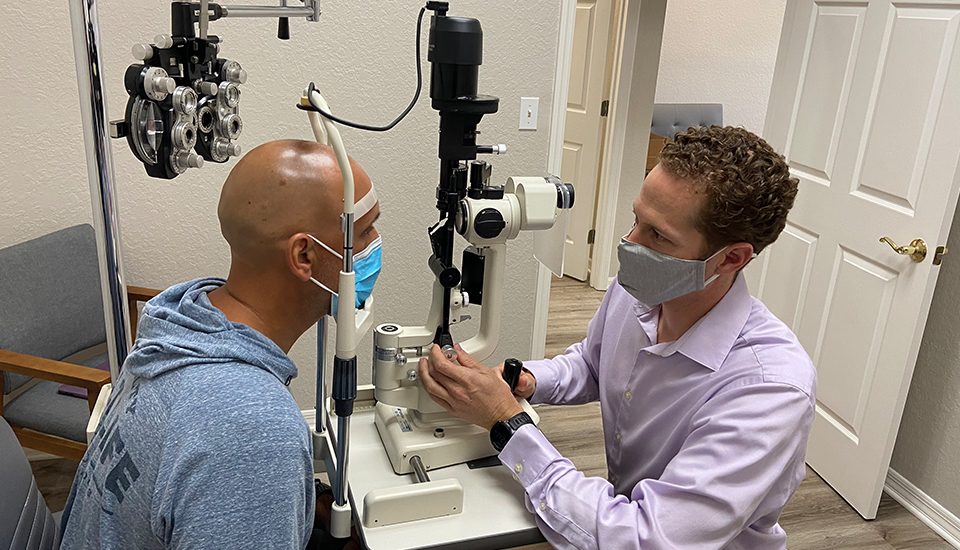
Superficial Keratectomy with Prokera Background
The cornea is the clear front part of the eye that you look through. It is made of several layers. The surface layer is made of epithelium (skin cells) which sit on a basement membrane. There are many diseases that affect the surface or epithelial layer of the cornea such as Salzmann nodular degeneration, Map Dot Fingerprint dystrophy, and recurrent corneal erosion syndrome. Diseases of the corneal epithelium can cause blurry vision, ghosting of letters, double vision, and recurrent eye pain. Many times, the diseased surface corneal layers can be polished and removed with a procedure called a superficial keratectomy. This can be comfortably performed in the clinic at the microscope with topical numbing eye drops for anesthesia.
PROCEDURE
The corneal epithelium (sink layers) are polished and removed from the cornea using a metal spatula to allow room for healthy skin to regrow in its place. After the abnormal skin is removed, an amniotic membrane ring called a Prokera (Biotissue) is placed on the ocular surface. The procedure itself is painless and takes only a few minutes to perform. Roughly 30 minutes after the procedure, however, there will be a sharp pain. It will feel like there is sand in the eye. This pain will last a few days but will improve by about 15% every day. You will receive rescue drops to help reduce the pain but they should be used sparingly as they can slow down the healing process. The eyelid will be taped down for a few days after the procedure. The plastic Prokera amniotic ring is then removed in the clinic 1 week later.
PROKERA AMNIOTIC MEMBRANE
The amniotic membrane is powerful healing tissue and is the same amnion that wraps around a baby during development. After C-section, the amnion graft is donated, tested, and processed by Biotissue and cryo-frozen for use. The amniotic membrane is full of powerful anti-scar factors, anti-inflammatory factors, and pro-healing factors and is used for spinal cord surgery, in burn victims, and for eye surgery to promote healing and reduce scarring. This is important because many times diseases on the surface of the cornea are associated with some scarring in the deeper layers of the cornea. The amniotic membrane ring helps minimize the risk of corneal scarring and helps regenerate healthy skin to regrow across the cornea. The membrane is held in place with a rigid plastic ring that sits on the eye. The plastic ring can be felt in the eye as an annoyance but it is preferred by patients for ease of placement and removal in the office. The alternative to the plastic ring is having the membrane graft sutured in place in the operating room.
PROCEDURE RECOVERY
There will be a piece of tape over the eye for comfort and protection afterward. The tape may fall off in a few days and that is ok. No need to replace the eyelid tape. You may also remove the piece of tape if it starts to bother you.
It is common and normal for your eye to hurt after the procedure. Scratchy, painful, gritty, tearing, soreness are all normal. You may take whatever you normally take for pain such as acetaminophen or ibuprofen. You may be prescribed other medications for pain after surgery. If you receive a prescription for alprazolam or tramadol please follow the instructions on use.
Pick up your medication eye drops PRIOR to the procedure as you will need to start them right away afterward. Your doctor will review your post-op medications with you so please bring them with you to your follow up appointment.
Light duty activities such as reading, TV and computers are ok but these activities can make your eyes feel more scratchy, sore, and dry.
RESUMING ACTIVITIES AFTER SURGERY
Wait to drive until advised by your doctor. You may resume normal activities and can wear eye makeup 2 weeks after surgery.
You may shower after surgery but face away from the water and avoid getting water directly in your eye for a few days.
NO SWIMMING POOLS, HOT TUBS, or GARDENING (LAWN MOWING) for 2 weeks after surgery. These activities increase your risk of serious eye infection during the post-op period.
You may wear your regular eyeglasses after surgery however the old prescription will no longer work in the surgical eye. Some people opt to remove the lens in front of the eye that had the procedure. Typically, glasses are prescribed about 4-6 weeks after surgery though sometimes it may be advised to wait longer for the eye to heal.
If you experience severe eye pain, a curtain, or veil in your vision, or a sudden shower of black dots, or a significant decrease in your vision then call the office immediately at 941-499-1570.
PROCEDURE RECOVERY
There will be a patch in place over the eye for comfort and protection after surgery. Please leave it in place until your appointment the following day. It is common and normal for your eye to be red and feel scratchy and sore after surgery. You may take acetaminophen (Tylenol) or ibuprofen (Motrin) for pain. If you receive a prescription for Ultram please follow the instructions on use.
Once the patch is removed, you may use lubricating drops to help. It is also normal for you to see glare and halos or foggy vision immediately after surgery. You can expect these changes in your vision to gradually improve in the days to weeks following surgery.
Pick up your medication eye drops PRIOR to surgery as you will need to start them right away after surgery. Your doctor will review your post op medications with you so please bring them with you to your follow up appointment.
You may resume your normal diet and medications immediately after surgery. Light duty activities such as reading, TV, computer are ok but these activities can make your eyes feel more scratchy, sore, and dry especially right after surgery.

